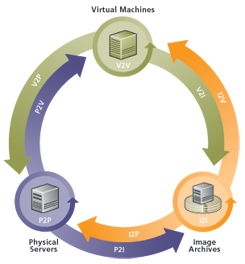1.1 About Workload Portability and Protection
Portability Suite automates the migration of workloads among three infrastructures: physical, virtual machine, and volume imaging. On virtual machine and imaging infrastructures, Portability Suite provides protection capabilities for business continuity.
Figure 1-1 Workload Portability

Table 1-1 Workload Portability and Protection Operations
Portability Suite supports multiple workload types and virtualization platforms. Protection and imaging are supported for workloads with Microsoft* Windows* operating systems. For a more detailed list of supported workloads and infrastructures, see Supported Source Workloads and Target Platforms.
1.1.1 Business Applications for Portability Suite
Portability Suite is designed to be used for the following scenarios:
-
Consolidation. Automating large-scale migrations of physical machines to virtual machines, accelerating consolidation projects, and reducing administrative effort and errors.
-
Migration. Moving fully configured workloads from old hardware to new hardware without rebuilding the entire software stack.
-
Test Lab Deployment. Consolidating test lab workloads by running multiple virtual machines on a single VM host, quickly deploying virtual test lab environments with ease, and replicating an entire production environment in matter of hours or days.
-
Disaster Recovery. Managing planned/unplanned outages through automated replication of physical or virtual production workloads to virtual machines. You can also switch to a virtual machine replica while the physical production workload is unavailable. This reduces downtime and hardware resource utilization, while maintaining business continuity.
-
Maintenance and Support Agreement Integrity. De-virtualizing workloads along with the applications installed on them and moving them back to physical machines over the network so that the support agreements can remain valid.
-
Machine Provisioning. Easily capturing an entire library of hardware-independent Flexible Images and deploying them to new infrastructures over the network without manually configuring the hardware, drivers, and so on.
-
Continuous Workload Optimization. Moving workloads to and from any geographical location, onto any platform, in any direction. Workloads can be virtualized or de-virtualized during ongoing and continuous optimization of resources.
1.1.2 Workload Conversion Tasks
Portability Suite enables you to define, save, schedule, execute, and monitor the following conversion tasks.
Table 1-2 Portability Suite Workload Conversion Tasks